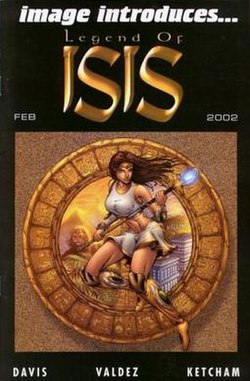
Osiris was the god of fertility, agriculture, the afterlife, the dead, resurrection, life, and vegetation in ancient Egyptian religion. He was classically depicted as a green-skinned deity with a pharaoh's beard, partially mummy-wrapped at the legs, wearing a distinctive atef crown, and holding a symbolic crook and flail. He was one of the first to be associated with the mummy wrap. When his brother Set cut him up into pieces after killing him, Osiris' wife Isis found all the pieces and wrapped his body up, enabling him to return to life. Osiris was widely worshipped until the decline of ancient Egyptian religion during the rise of Christianity in the Roman Empire.

Isis was a major goddess in ancient Egyptian religion whose worship spread throughout the Greco-Roman world. Isis was first mentioned in the Old Kingdom as one of the main characters of the Osiris myth, in which she resurrects her slain brother and husband, the divine king Osiris, and produces and protects his heir, Horus. She was believed to help the dead enter the afterlife as she had helped Osiris, and she was considered the divine mother of the pharaoh, who was likened to Horus. Her maternal aid was invoked in healing spells to benefit ordinary people. Originally, she played a limited role in royal rituals and temple rites, although she was more prominent in funerary practices and magical texts. She was usually portrayed in art as a human woman wearing a throne-like hieroglyph on her head. During the New Kingdom, as she took on traits that originally belonged to Hathor, the preeminent goddess of earlier times, Isis was portrayed wearing Hathor's headdress: a sun disk between the horns of a cow.

The Osiris myth is the most elaborate and influential story in ancient Egyptian mythology. It concerns the murder of the god Osiris, a primeval king of Egypt, and its consequences. Osiris's murderer, his brother Set, usurps his throne. Meanwhile, Osiris's wife Isis restores her husband's body, allowing him to posthumously conceive their son, Horus. The remainder of the story focuses on Horus, the product of the union of Isis and Osiris, who is at first a vulnerable child protected by his mother and then becomes Set's rival for the throne. Their often violent conflict ends with Horus's triumph, which restores maat to Egypt after Set's unrighteous reign and completes the process of Osiris's resurrection.

Nut, also known by various other transcriptions, is the goddess of the sky, stars, cosmos, mothers, astronomy, and the universe in the ancient Egyptian religion. She was seen as a star-covered nude woman arching over the Earth, or as a cow. She was depicted wearing the water-pot sign (nw) that identifies her.

Shu was one of the primordial Egyptian gods, spouse and brother to the goddess Tefnut, and one of the nine deities of the Ennead of the Heliopolis cosmogony. He was the god of peace, lions, air, and wind.

Nephthys or Nebet-Het in ancient Egyptian was a goddess in ancient Egyptian religion. A member of the Great Ennead of Heliopolis in Egyptian mythology, she was a daughter of Nut and Geb. Nephthys was typically paired with her sister Isis in funerary rites because of their role as protectors of the mummy and the god Osiris and as the sister-wife of Set.

Black Adam, real name Teth-Adam, is a fictional character appearing in American comic books published by DC Comics. He was created by Otto Binder and C. C. Beck, and first appeared in the debut issue of Fawcett Comics' The Marvel Family comic book in December 1945. Since DC Comics licensed and acquired Fawcett's characters in the 1970s, Black Adam has endured as one of the most popular archenemies of the superhero Captain Marvel / Shazam and the Marvel Family alongside Doctor Sivana and Mister Mind.

Mary Marvel is a fictional character and superheroine originally published by Fawcett Comics and now owned by DC Comics. Created by Otto Binder and Marc Swayze, she first appeared in Captain Marvel Adventures #18. The character is a member of the Marvel / Shazam Family of heroes associated with the superhero Shazam / Captain Marvel and is one of the first female spin-offs of a major male superhero, and predates the introduction of Supergirl by more than a decade.

Jessica Campbell Jones-Cage, professionally known as Jessica Jones, is a superheroine appearing in American comic books published by Marvel Comics. The character was created by writer Brian Michael Bendis and artist Michael Gaydos and first appeared in Alias #1 as part of Marvel's Max, an imprint for more mature content, and was later retroactively established to have first appeared in The Amazing Spider-Man #4 in the Silver Age of Comic Books as an unnamed classmate of Peter Parker, created by writer-editor Stan Lee and artist Steve Ditko. Within the context of Marvel's shared universe, Jones is a former superhero who becomes the owner of Alias Private Investigations. Bendis envisioned the series as centered on Jessica Drew and only decided to create Jones once he realized that the main character he was writing had a distinct-enough voice and background to differentiate her from Drew, though deciding to still name the character after her on the basis of how "two [people] can have the same first name".
Alias Enterprises is an American publishing company. Their main divisions are Alias Comics and Cross Culture. Based in San Diego, California, it was founded in January 2005 by Brett Burner and Mike S. Miller. They publish comics such as Lullaby, The 10th Muse, The Legend of Isis, and Sixgun Samurai.
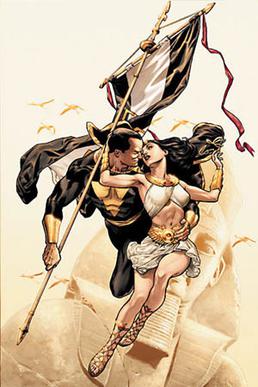
Isis is the name of several female characters appearing in American comic books published by DC Comics. The name is associated with the DC Universe's iteration of the ancient Egyptian goddess of the same name and others who have adopted the name.
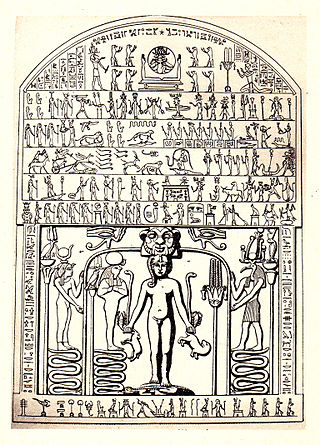
The Metternich Stela is a magico-medical Horus on the Crocodiles stele that is part of the Egyptian collection of the Metropolitan Museum of Art in New York City. It dates to the Thirtieth Dynasty of Egypt around 380–342 B.C. during the reign of Nectanebo II. The provenance of the stele is unknown.
Certain numbers were considered sacred, holy, or magical by the ancient Egyptians, particularly 2, 3, 4, 7, and their multiples and sums.

The Secrets of Isis, originally broadcast as Isis, is an American live-action superhero television series produced by Filmation from 1975 to 1976 for CBS's Saturday morning lineup. The series was renamed The Secrets of Isis in syndication.
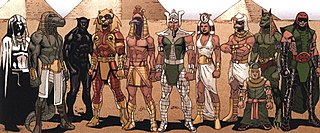
Heliopolitans are a fictional group of gods, based on Ancient Egyptian deities, appearing in American comic books published by Marvel Comics.

Amon Tomaz, known as Osiris, is a fictional character appearing in American comic books published by DC Comics. Making his full debut in 52 #23, the character serves as analogue to Captain Marvel Jr. / Shazam Jr, sharing a significant connections to the character Black Adam, who is depicted as both a villain and anti-hero.
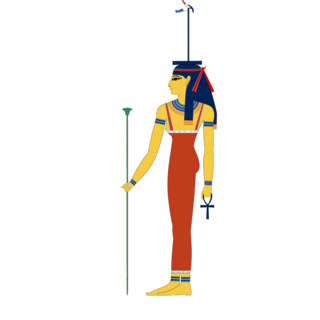
Wosret, Waset, or Wosyet meaning "the powerful female one" was an Egyptian goddess whose cult was centered on Thebes in Upper Egypt and her name was the same as the Egyptian name of the city, Waset. She was a minor goddess, but three pharaohs during the Twelfth Dynasty incorporated her name into theirs: Senwosret, or Senusret, means "man of Wosret".

Darren G. Davis is an American independent comic book publisher and writer. He is the head of TidalWave Productions based in Portland, Oregon.

TidalWave Productions is an independent production studio of comic books and graphic novels. Based in Portland, Oregon, United States, Bluewater publishes biographical comics, adaptations from films, and original titles with self-created characters.

The mysteries of Isis were religious initiation rites performed in the cult of the Egyptian goddess Isis in the Greco-Roman world. They were modeled on other mystery rites, particularly the Eleusinian mysteries in honor of the Greek goddesses Demeter and Persephone, and originated sometime between the third century BCE and the second century CE. Despite their mainly Hellenistic origins, the mysteries alluded to beliefs from ancient Egyptian religion, in which the worship of Isis arose, and may have incorporated aspects of Egyptian ritual. Although Isis was worshipped across the Greco-Roman world, the mystery rites are only known to have been practiced in a few regions. In areas where they were practiced, they served to strengthen devotees' commitment to the Isis cult, although they were not required to worship her exclusively, and devotees may have risen in the cult's hierarchy by undergoing initiation. The rites may also have been thought to guarantee that the initiate's soul, with the goddess's help, would continue after death into a blissful afterlife.
